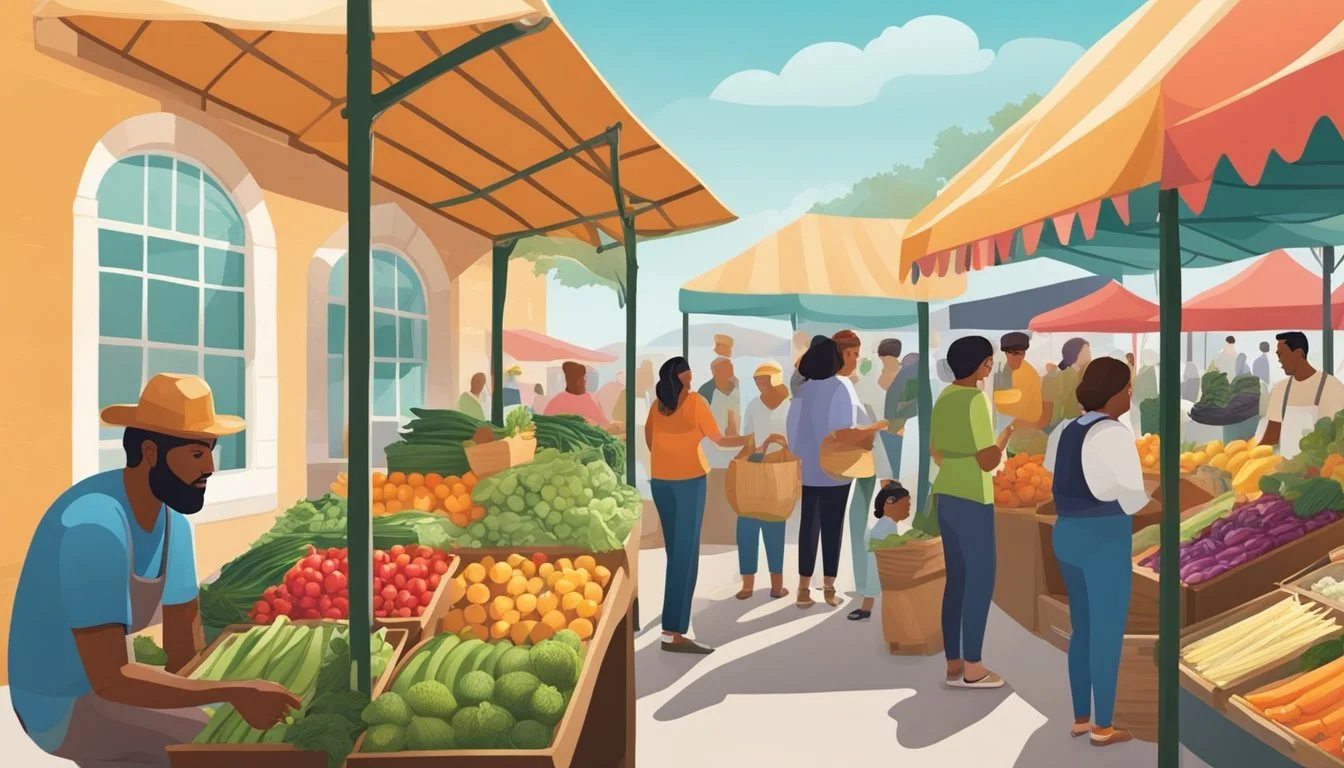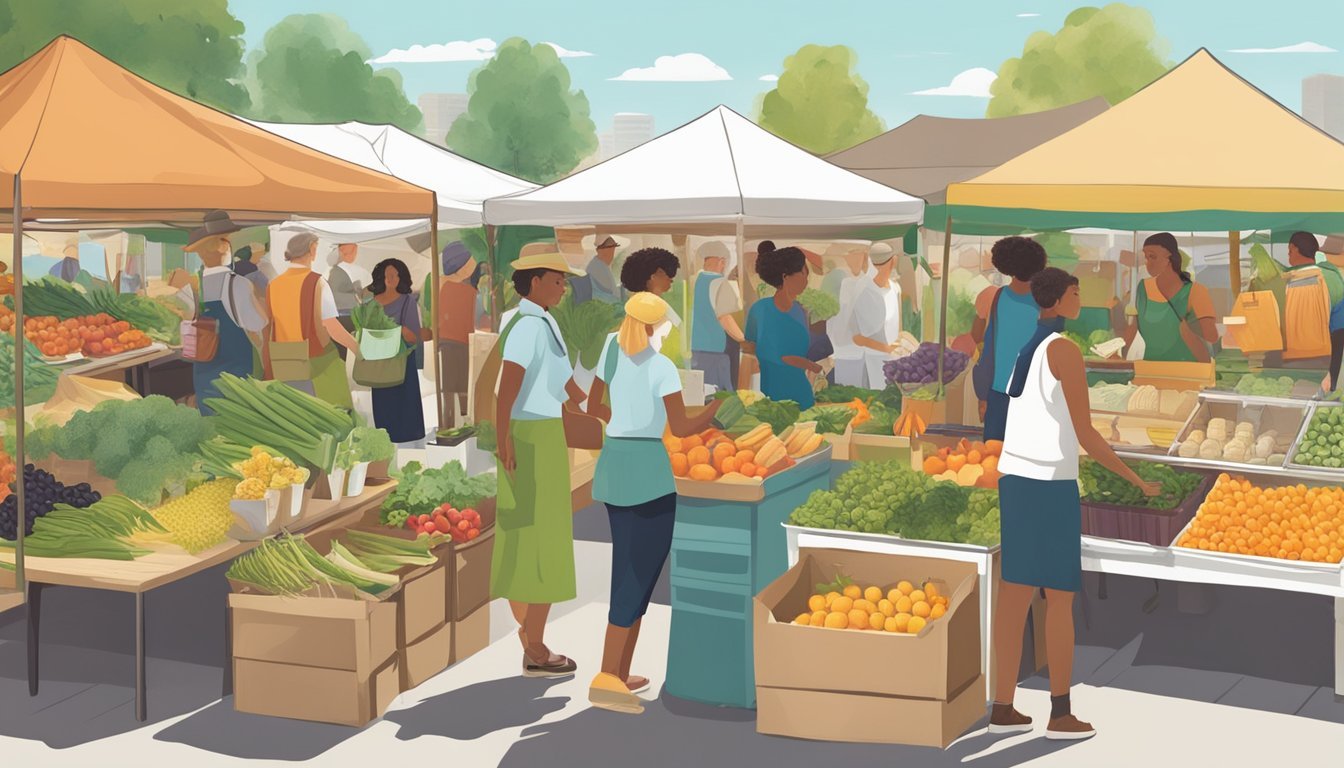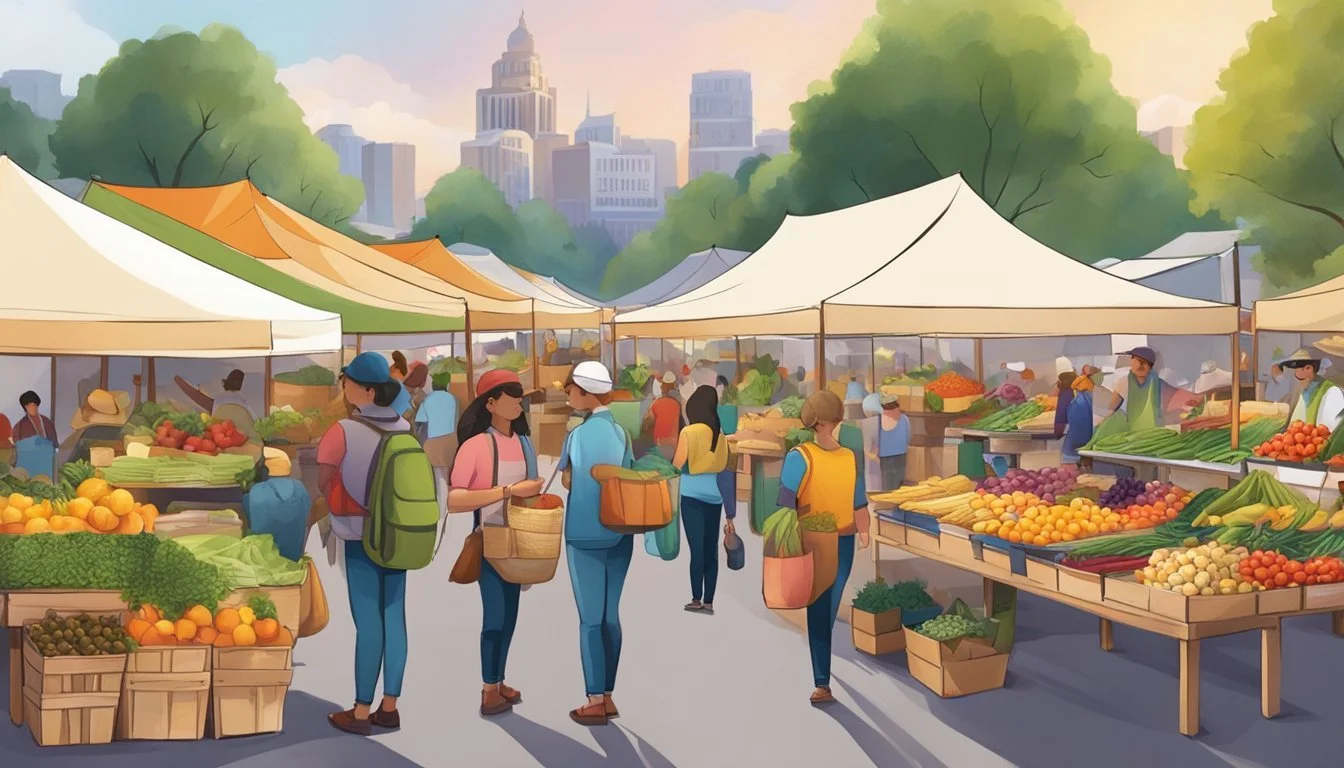The Rise of Craft Foods
Exploring the Farmers' Market Revolution
Farmers markets across the United States have long been the cornerstone for local agriculture, providing a venue where consumers can purchase freshly picked produce and interact directly with the growers. The evolution of these markets has seen a significant shift with the burgeoning popularity of craft foods, a trend that celebrates regional flavors and traditional food-making techniques. This renaissance of artisanal foods at farmers markets is a response to the growing consumer demand for sustainable, locally-sourced, and high-quality specialty products.
The term "craft foods" encompasses a wide array of products including cheeses, breads, cured meats (What wine goes well with cured meats?), and preserves that reflect the skills and dedication of small-scale producers. Moving away from the industrial food complex, these artisans draw upon time-honored methods to create unique and flavorful products that emphasize quality over quantity. Often, they adhere to principles of organic and non-intensive farming, fostering a food environment that supports the health of both people and the planet.
With a more discerning public that values the narrative behind what they consume, farmers markets have become essential destinations for discovering craft foods. Here, every loaf of sourdough bread or wheel of cheese tells a story of local heritage and the producer's commitment to excellence. This trend is not just a passing fad but a significant movement towards a more conscious and connected food culture.
The Evolution of Craft Foods
In the last decade, the emergence of craft foods has significantly altered the culinary landscape. This shift prioritizes quality and sustainability, marking a move away from mass-produced food items. Craft foods embody a synergy of traditional techniques and a renewed emphasis on flavor and authenticity, aligning closely with the local food movement and environmental movement.
Local Economy: Small-scale producers have seen a resurgence, as consumers seek locally-sourced ingredients. This has economically benefitted regional farmers and artisans by keeping the revenue within the community.
Sustainability: The craft food movement is entwined with sustainable practices. The emphasis on local sourcing helps reduce transportation and thus, the carbon footprint.
Quality: Craft foods often boast superior quality, with producers leveraging artisanal methods that have been passed down through generations.
A notable aspect of this evolution is the consumers' growing awareness and support for environmentally-friendly initiatives. They increasingly demand transparency and ethical production methods, further bolstering the craft food sector.
Market Aspect Impact of Craft Foods Consumer Demand Increased for premium, artisanal products Variety Expanded range of unique, local offerings Environmental Impact Lowered through sustainable practices
The growth of the craft food market is not simply a trend but rather an indicator of a collective shift towards greener, more responsible consumption patterns. The green ethos resonates strongly within this space, further catalyzing the popularity of farmers' markets where these products are often showcased. The evolution of craft foods is a testament to their role in shaping a more sustainable and quality-focused food system.
Farmers Markets: Catalysts for Change
Farmers markets have long stood as cornerstones of community, embodying multifunctional markets that prioritize fresh, local produce. These markets serve not only as venues for commerce but also as placemaking hubs, fostering social interactions and community bonding. The Farmers Market Coalition champions this movement, promoting a model where farmers benefit from direct sales and consumers enjoy access to nutritious food.
Multifunctional Markets: Farmers markets have transformed public spaces into thriving meeting points. They encourage a mix of uses, driving change by supporting local agriculture and providing a platform for educational community programs.
Community and Placemaking: These gatherings are more than just markets; they're social frameworks that reinvent public areas as communal hearts. They serve to increase social ties and enable residents to shape their neighborhoods, which enhances the sense of belonging.
Consumer Education: Engagement at farmers markets educates consumers on seasonal diets, sustainable agriculture, and the significance of supporting local economies. This empowers consumers with the knowledge to make informed food choices.
Economic Catalyst: The exchange between local producers and buyers at farmers markets not only sustains local farmers but also injects vitality into downtown districts, acting as incubators for emerging businesses.
By fostering an environment where producers and consumers can interact, farmers markets are carving pathways for social and economic revitalization, yielding benefits that extend beyond the market itself.
Impact of COVID-19 on Local Food Ecosystems
The COVID-19 pandemic has fundamentally transformed local food ecosystems, altering consumer behavior, challenging farmers and markets, and reshaping the landscape of food access and security.
Shift in Consumer Behavior
The arrival of the pandemic led to abrupt shifts in how consumers approached food purchases. A surge in demand for healthy food options was documented as individuals became more health-conscious, seeking to bolster their immune systems. Panic buying and stockpiling behavior resulted in food insecurity for others, putting a strain on grocery store supply chains. Consumers increasingly turned to local food sources and farmers' markets as alternatives to empty supermarket shelves and to reduce exposure to the virus in crowded stores. The adoption of drive-thru pickup services and online orders from local producers increased, aiding food access during the pandemic.
Preference for Local: Consumers prioritized local and fresh produce over prepackaged goods.
Food Security Concerns: The disruption to traditional food supplies highlighted the importance of local markets in ensuring continuous access to food during crises.
Response of Farmers and Markets
Farmers and local markets responded to the pandemic's challenges with resilience and innovation. Shutdowns and social distancing measures necessitated the rapid adoption of new sales methods such as online ordering and contactless pickup. Many markets introduced drive-thru pickup services to maintain operations and support food access. To address heightened food security issues, various programs such as the Pandemic Electronic Benefits Transfer and the Coronavirus Food Assistance Program were implemented to support both consumers and farmers financially.
Operational Adjustments: Adaptations to enable safe shopping environments and maintain supply chains.
Support Programs: Aid for both consumers and producers to sustain the local food ecosystem amidst economic hardships.
Health and Wellness Considerations
This section addresses the multifaceted role that farmers' markets play in promoting health and wellness through access to fresh, local produce while also serving as a beacon of hope in areas marred by food deserts and insecurity.
Advantages of Fresh Local Produce
Farmers’ markets are treasure troves of local food, including an array of fresh, seasonal produce that often bypasses the lengthy supply chains of supermarkets. Children and adults alike have the opportunity to purchase organic products directly from the source, which may support a stronger connection to healthy eating practices. The freshness of local foods is not just a matter of taste but also a boon for health, as the shortened time from farm to table can result in higher nutrient content.
Studies in nutrition science have shown that fresher produce may retain more vitamins and antioxidants, and regular consumption can contribute to improved wellness. Additionally, the availability of healthy food options at farmers' markets can be a valuable ally in combating health problems such as obesity, which is a growing concern across various demographics.
Confronting Food Deserts and Insecurity
Farmers' markets have the potential to transform food deserts into oases of nourishment. These markets bring wholesome, affordable food options to areas where supermarkets and healthy food retailers are scarce, thereby directly tackling the issue of food insecurity. By offering fresh produce in underprivileged neighborhoods, they make strides toward equalizing access to nutritious foods that are essential for a healthy lifestyle.
Governments and organizations increasingly recognize the role of farmers’ markets in supporting health and wellness within communities. They implement policies that encourage the establishment of these markets in areas plagued by limited food choices. Through these efforts, farmers' markets serve as critical vehicles for change, providing viable solutions to food insecurity and contributing to the collective health of the community.
Socioeconomic Benefits of Craft Foods
Craft foods, produced and sold by local artisans, offer substantial socioeconomic advantages, encompassing enhancements to both the local economy and the community ethos.
Strengthening the Local Economy
Local Economic Impact: The rise of craft foods has been a boon for local economies. Sales from farmers' markets provide a direct financial stream to farmers and artisans, bypassing the costs associated with middlemen. A significant portion of every dollar spent circulates back into the local economy, incentivizing regional growth. Nonprofit organizations often benefit from this model, gaining increased support that allows them to further aid in food security initiatives.
Job Creation: Artisans and small-scale farmers are stepping stones in bolstering the local job market. Each craft food vendor represents potential employment and skills development opportunities.
Food Supply Sustenance: The presence of craft foods ensures a more resilient local food supply. In contrast to the complex distribution networks of large grocery stores, local markets can adapt more rapidly to supply chain disruptions, maintaining access to fresh produce.
Fostering Community and Values
Community Engagement: Farmers' markets act as community hubs, fostering connections amongst residents, and creating a shared space for exchange beyond the goods. They play a vital role in reinforcing community values, centered on sustainability and mutual support.
Educational Outreach: Producers at farmers’ markets often engage in educational activities, sharing knowledge on food origins and production. This transparency builds trust within the community.
A Reinforcement of Values: The transactions at farmers' markets are often values-driven. Consumers tend to support these markets not just for the quality of product, but also for the ideals they represent, such as environmental stewardship and support for local entrepreneurship.
Sustainable Practices and Environmental Impact
Farmers' markets have become not only social and community-centric hubs but also strongholds for sustainability. The rise of craft foods is linked with an increased awareness of the ecological benefits these markets foster. They support small-scale agriculture and often encourage organic and biodynamic farming practices, which play a significant role in preserving the environment.
Ecologically, farmers’ markets help to lower carbon footprint. Local sourcing means shorter distances for food to travel, reducing transportation emissions. It is estimated that food in the United States travels an average of 1,500 miles from farm to plate, emitting substantial carbon emissions in the process. In contrast, foods at farmers' markets often travel less than 100 miles, drastically cutting down on associated emissions.
The relationship between these markets and their environmental impact is highlighted by the following:
Reduced Packaging: Vendors typically use minimal packaging, cutting down waste generation.
Fresh Produce: Short travel distances ensure produce is picked at peak ripeness, creating less spoilage and food waste.
Furthermore, many markets have adopted sustainable practices such as composting and recycling, thus further reducing their environmental impact. In summary, farmers' markets contribute positively to the environment by promoting sustainable practices that limit waste and reduce carbon emissions.
The Role of Organizations and Technology
In shaping the craft food movement, organizations have played a vital role by fostering sustainable development, while technology investments have advanced the connectivity and efficiency of local food systems.
Nonprofits and Food Coalitions
Nonprofit organizations, such as Feeding America and local food coalitions, are central figures in supporting craft food trends, particularly at farmers' markets. Through their advocacy and services, they provide crucial support and resources to smaller producers. These organizations often facilitate the use of federal benefits at local markets. For example, SNAP benefits and Pandemic Electronic Benefit Transfer (P-EBT) cards are increasingly accepted at farmers' markets, broadening access to artisanal and locally-produced foods for low-income individuals.
The USDA collaborates with these nonprofits to maximize the usage of federal benefits.
Farmers Market Coalition works to strengthen farmers' markets for the benefit of farmers, consumers, and communities.
Innovations in Market Technology
Modern technology investments have significantly enhanced the transactional processes at farmers' markets. Electronic Benefits Transactions (EBT) systems have been implemented to streamline the purchasing process for consumers using federal benefits.
EBT systems allow for a smoother transaction process without the need for physical currency exchange.
Technology has been leveraged to measure ecosystem metrics, providing valuable data on sales trends and market performance.
By implementing such technologies, farmers' markets can offer a more inclusive shopping experience, ensuring clientele from varying economic backgrounds can partake in the craft food movement.
Policy and Infrastructure Support
To bolster the rise of craft foods within farmers' markets, policy and infrastructure play pivotal roles. Cities and governments have introduced a variety of schemes to ensure that urban and rural food systems are integrated and supported, focusing on food access, transportation, and economic viability for local farmers.
Urban Planning and Food Systems
Urban planning is integral to the development of robust food systems. By prioritizing food access in city planning, urban areas can become more conducive to sustainable, local food production and distribution. City planners often collaborate with local farmers and market organizers to identify suitable locations for farmers' markets, which are essential platforms for craft foods. Such planning includes ensuring access to transportation for both vendors and consumers, which directly impacts the viability and success of these markets.
Accessibility Features:
Proximity to public transport
Parking facilities for vendors and shoppers
Pedestrian-friendly areas around market sites
Government Programs and Assistance
The government has introduced several programs to support farmers' markets and craft food producers. The Supplemental Nutrition Assistance Program (SNAP) is a significant initiative that has been expanded to many farmers' markets, providing greater food access to lower-income individuals and increasing sales for local farmers. The Coronavirus Food Assistance Program (CFAP) has offered economic relief for farmers affected by market disruptions. Moreover, initiatives like Farm 2 Facts provide market managers with data tools to measure and communicate the impact of farmers' markets on local communities.
Key Government Programs:
USDA's Farmers' Market Promotion Program (FMPP)
Local Food Promotion Program (LFPP)
Specialty Crop Block Grant Program (SCBGP)
By harnessing policy and infrastructure, sectors ranging from urban to rural areas are actively creating a more resilient and sustainable craft food movement within farmers' markets.
Direct-to-Consumer Movements
The direct-to-consumer approach emphasizes selling fresh produce and various authentic products straight from production sites like farm stands and CSAs, providing a unique shopping experience through community gardens and special events.
Farm Stands and CSAs
Farm stands serve as the quintessence of direct-to-consumer sales, offering a diversity of freshly harvested produce to the local community. They embody the authenticity and freshness consumers seek, directly connecting them with the source of their food. Community Supported Agriculture (CSA) models have garnered recognition for securing a stable consumer base for local farms.
Farm Stands:
Variety: Wide range of seasonal offerings
Authenticity: Genuine interaction with food producers
CSAs:
Production: Shareholders receive regular produce allocations
Communal Support: Direct engagement with agriculture
Community Gardens and Special Events
Community gardens provide a dual benefit: they are a place for local food production and also a venue for special events that celebrate local food culture. These events showcase the diversity of craft foods and foster a sense of community, while creating opportunities for farmers to engage directly with the consumer.
Community Gardens:
Authenticity: Spaces for individuals to grow their own produce
Production: Local, sustainable food sources for neighborhood residents
Special Events:
Variety: Farmers and artisans present an array of local products
Community Connection: Events like harvest festivals strengthen the bond between growers and consumers
Consumer Engagement and Education
Farmers' markets have become a nexus for consumer education and engagement in the craft food movement. They provide a unique platform where restaurants, food enthusiasts, and the general public can connect directly with producers. This direct connection offers an educational opportunity that is seldom found in traditional retail environments dominated by corporations.
Customers at farmers' markets often engage in a learning exchange; they have the chance to ask questions about the food sources, the methods of production, and the stories behind the craft items. Producers, in turn, provide evidence of their farming practices, share knowledge, and influence consumer decision-making. This transparent dialogue fosters a deeper understanding and appreciation of craft foods.
Through this interaction, consumers become equipped with the knowledge to make informed choices about their purchases. Educational signage and pamphlets commonly found at such markets also play a role in shaping buyer awareness. Moreover, chefs and restaurant owners frequent these markets, looking for quality ingredients that reflect their culinary values, which often includes using locally sourced, artisanal products.
Restaurants tying their menus to the local farmers' marketplace positively influence consumer education. They not only support the ideology of consuming craft foods but also demonstrate the application of these products in sophisticated culinary traditions.
The prominence of farmers' markets in advancing consumer education is also echoed in the article facet of the phenomenon. Media coverage aids in providing detailed insights into the values and benefits of craft foods, further solidifying these markets as essential educational hubs.
Challenges and Future Outlook
Farmers' markets are confronting a breadth of challenges as they adapt to the growth of craft foods. One major hurdle remains transportation. Vendors must transport their goods to and from these events, facing logistical complexities and costs that can impact the viability of their operations. Coupled with this is competition from large-scale retail stores, which offer a plethora of food options, often at lower prices due to economies of scale.
Street vendors and farmers' markets also face the issue of market saturation. With the expansion of markets nationwide, individual vendors may struggle with decreased sales and heightened competition. A market's success is intrinsically linked to its food sources—the local farmers and artisans that supply it. Sourcing high-quality, diverse products that resonate with consumer trends is a constant balancing act.
Looking Ahead
Diversification: Expanding product offerings and catering to niche tastes.
Sustainability: Employing eco-friendly practices in sourcing and transportation.
Community Engagement: Building a loyal customer base through events and outreach.
Innovation: Embracing new technologies for payment and inventory management.
Despite these challenges, the farmers' market as an institution remains robust, with a strong outlook thanks to the growing consumer demand for craft and artisanal foods. Their future success will hinge on navigating market saturation, maintaining strong relationships with food sources, and enhancing the overall market experience for both vendors and consumers.








